Genome-Wide Identification and Expression Pattern of the GRAS Gene Family in Pitaya (Selenicereus undatus L.)
Abstract
:Simple Summary
Abstract
1. Introduction
2. Materials and Methods
2.1. Retrieval of GRAS Family Members in Pitaya
2.2. Domain Analysis of HuGRAS Proteins
2.3. Phylogenetic Analysis of HuGRAS Family
2.4. HuGRAS Genes Distribution on Pitaya Chromosomes
2.5. Pattern and Distribution of Conserved Motifs
2.6. Expression Analysis of HuGRAS Genes
2.7. Network Analysis of HuGRAS Proteins
2.8. Cis-Acting Element Analysis in HuGRAS Promoter Sequences
2.9. Plant Materials
2.10. RNA Isolation and Real-Time Quantitative PCR Expression Analysis
3. Results
3.1. Genome-Wide Identification of the GRAS Family in Pitaya
3.2. Phylogenetic Analysis of the GRAS Gene Family
3.3. HuGRAS-Protein Sequence Alignments and Conserved Motifs
3.4. Gene Structure and Distribution of HuGRAS Genes on Chromosomes
3.5. Expression Analysis of HuGRAS Genes in Different Tissues of Pitaya
3.6. HuGRAS Proteins Network Analysis
3.7. Identification of Cisacting Elements in HuGRAS Promoter Sequences
3.8. Expression of HuGRAS Genes at Developmental Stages of Pitaya
4. Discussion
5. Conclusions
Supplementary Materials
Author Contributions
Funding
Institutional Review Board Statement
Informed Consent Statement
Data Availability Statement
Acknowledgments
Conflicts of Interest
References
- Mercado-Silva, E.M. Pitaya-Hylocereus undatus (Haw). In Exotic Fruits; Rodrigues, S., de Oliveira Silva, E., de Brito, E.S., Eds.; Academic Press: Cambridge, MA, USA, 2018; pp. 339–349. [Google Scholar] [CrossRef]
- Chen, J.Y.; Xie, F.F.; Cui, Y.Z.; Chen, C.B.; Lu, W.J.; Hu, X.D.; Hua, Q.Z.; Zhao, J.; Wu, Z.J.; Gao, D.; et al. A chromosome-scale genome sequence of pitaya (Hylocereus undatus) provides novel insights into the genome evolution and regulation of betalain biosynthesis. Hortic. Res. 2021, 8, 164. [Google Scholar] [CrossRef] [PubMed]
- Cai, X.; Zhang, L.; Xiao, L.; Wen, Z.; Hou, Q.; Yang, K. Genome-wide identification of GRF gene family and their contribution to abiotic stress response in pitaya (Hylocereus polyrhizus). Int. J. Biol. Macromol. 2022, 223, 618–635. [Google Scholar] [CrossRef] [PubMed]
- Paśko, P.; Galanty, A.; Zagrodzki, P.; Ku, Y.G.; Luksirikul, P.; Weisz, M.; Gorinstein, S. Bioactivity and cytotoxicity of different species of pitaya fruits-A comparative study with advanced chemometric analysis. Food Biosci. 2021, 40, 100888. [Google Scholar] [CrossRef]
- Song, Y.; Cui, H.; Shi, Y.; Xue, J.; Ji, C.; Zhang, C.; Yuan, L.; Li, R. Genome-wide identification and functional characterization of the Camelina sativa WRKY gene family in response to abiotic stress. BMC Genom. 2020, 21, 786. [Google Scholar] [CrossRef] [PubMed]
- Xia, H.; Liu, X.; Lin, Z.; Zhang, X.; Wu, M.; Wang, T.; Deng, H.; Wang, J.; Lin, L.; Deng, Q.; et al. Genome-wide identification of MYB transcription factors and screening of members involved in stress response in Actinidia. Int. J. Mol. Sci. 2022, 23, 2323. [Google Scholar] [CrossRef] [PubMed]
- Lakhwani, D.; Vikarm Dhar, Y.; Singh, S.; Pandey, A.; Kumar Trivedi, P.; Hasan Asif, M. Genome wide identification of MADS box gene family in Musa balbisiana and their divergence during evolution. Gene 2022, 836, 146666. [Google Scholar] [CrossRef]
- Pratt, I.S.; Zhang, B. Genome-wide identification of ARF transcription factor gene family and their expression analysis in sweet potato. Int. J. Mol. Sci. 2021, 22, 9391. [Google Scholar] [CrossRef]
- Yamada, Y.; Nishida, S.; Shitan, N.; Sato, F. Genome-wide identification of AP2/ERF transcription factor-encoding genes inCalifornia poppy (Eschscholzia californica) and their expression profiles in response to methyl jasmonate. Sci. Rep. 2020, 10, 18066. [Google Scholar] [CrossRef]
- Li, Y.; Zhu, Y.; Yao, J.; Zhang, S.; Wang, L.; Guo, C.; van Nocker, S.; Wang, X. Genome-wide identification and expression analyses of the homeobox transcription factor family during ovule development in seedless and seeded grapes. Sci. Rep. 2017, 7, 12638. [Google Scholar] [CrossRef]
- Zhou, Q.; Zhang, S.; Chen, F.; Liu, B.; Wu, L.; Li, F.; Zhang, J.; Bao, M.; Liu, G. Genome-wide identification and characterization of the SBP-box gene family in petunia. BMC Genom. 2018, 19, 193. [Google Scholar] [CrossRef]
- Manzoor, M.A.; Manzoor, M.M.; Li, G.; Abdullah, M.; Han, W.; Wenlong, H.; Shakoor, A.; Riaz, M.W.; Rehman, S.; Cai, Y. Genome-wide identification and characterization of bZIP transcription factors and their expression profile under abiotic stresses in Chinese pear (Pyrus bretschneideri). BMC Plant Biol. 2021, 21, 413. [Google Scholar] [CrossRef] [PubMed]
- Raza, A.; Sharif, Y.; Chen, K.; Wang, L.; Fu, H.; Zhuang, Y.; Chitikineni, A.; Chen, H.; Zhang, C.; Varshney, R.K.; et al. Genome wide characterization of ascorbate peroxidase gene family in peanut (Arachis hypogea L.) revealed their crucial role in growth and multiple stress tolerance. Front. Plant Sci. 2022, 13, 962182. [Google Scholar] [CrossRef] [PubMed]
- Kumari, P.; Gahlaut, V.; Kaur, E.; Singh, S.; Kumar, S.; Jaiswal, V. Genome-Wide Identification of GRAS Transcription Factors and Their Potential Roles in Growth and Development of Rose (Rosa chinensis). J. Plant Growth Regul. 2022, 1–17. [Google Scholar] [CrossRef]
- Ni, L.; Wang, Z.; Liu, X.; Wu, S.; Hua, J.; Liu, L.; Yin, Y.; Li, H.; Gu, C. Genome-wide study of the GRAS gene family in Hibiscus hamabo Sieb. et Zucc and analysis of HhGRAS14-induced drought and salt stress tolerance in Arabidopsis. Plant Sci. 2022, 319, 111260. [Google Scholar] [CrossRef] [PubMed]
- Song, X.M.; Liu, T.K.; Duan, W.K.; Ma, Q.H.; Ren, J.; Wang, Z.; Li, Y.; Hou, X.L. Genome-wide analysis of the GRAS gene family in Chinese cabbage (Brassica rapa ssp. pekinensis). Genomics 2014, 103, 135–146. [Google Scholar] [CrossRef] [Green Version]
- Wang, X.; Li, G.; Sun, Y.; Qin, Z.; Feng, P. Genome-wide analysis and characterization of GRAS family in switchgrass. Bioengineered 2021, 12, 6096–6114. [Google Scholar] [CrossRef]
- Zhang, H.; Liu, X.; Wang, X.; Sun, M.; Song, R.; Mao, P.; Jia, S. Genome-wide identification of GRAS gene family and their responses to abiotic stress in Medicago sativa. Int. J. Mol. Sci. 2021, 22, 7729. [Google Scholar] [CrossRef]
- Shan, Z.; Luo, X.; Wu, M.; Wei, L.; Fan, Z.; Zhu, Y. Genome-wide identification and expression of GRAS gene family members in cassava. BMC Plant Biol. 2020, 20, 46. [Google Scholar] [CrossRef] [Green Version]
- Liu, S.; Wang, X.; Wang, H.; Xin, H.; Yang, X.; Yan, J.; Li, J.; Tran, L.S.P.; Shinozaki, K.; Yamaguchi-Shinozaki, K.; et al. Genome wide analysis of ZmDREB genes and their association with natural variation in drought tolerance at seedling stage of Zea mays L. PLoS Genet. 2013, 9, e1003790. [Google Scholar] [CrossRef]
- Wang, T.T.; Yu, T.F.; Fu, J.D.; Su, H.G.; Chen, J.; Zhou, Y.B.; Chen, M.; Guo, J.; Ma, Y.Z.; Wei, W.L.; et al. Genome-wide analysis of the GRAS gene family and functional identification of GmGRAS37 in drought and salt tolerance. Front. Plant Sci. 2020, 11, 604690. [Google Scholar] [CrossRef]
- Dutta, M.; Saha, A.; Moin, M.; Kirti, P.B. Genome-wide identification, transcript profiling and bioinformatic analyses of GRAS transcription factor genes in rice. Front. Plant Sci. 2021, 12, 777285. [Google Scholar] [CrossRef] [PubMed]
- Wang, S.; Duan, Z.; Yan, Q.; Wu, F.; Zhou, P.; Zhang, J. Genome-wide identification of the GRAS family genes in Melilotus albus and expression analysis under various tissues and abiotic stresses. Int. J. Mol. Sci. 2022, 23, 7403. [Google Scholar] [CrossRef] [PubMed]
- Liu, Y.; Wang, W. Characterization of the GRAS gene family reveals their contribution to the high adaptability of wheat. Peer J. 2021, 9, e10811. [Google Scholar] [CrossRef]
- Guo, P.; Wen, J.; Yang, J.; Ke, Y.; Wang, M.; Liu, M.; Ran, F.; Wu, Y.; Li, P.; Li, J.; et al. Genome-wide survey and expression analyses of the GRAS gene family in Brassica napus reveals their roles in root development and stress response. Planta 2019, 250, 1051–1072. [Google Scholar] [CrossRef] [PubMed] [Green Version]
- Fan, Y.; Wei, X.; Lai, D.; Yang, H.; Feng, L.; Li, L.; Niu, K.; Chen, L.; Xiang, D.; Ruan, J.; et al. Genome-wide investigation of the GRAS transcription factor family in foxtail millet (Setaria italica L.). BMC Plant Biol. 2021, 21, 508. [Google Scholar] [CrossRef] [PubMed]
- Wang, L.; Ding, X.; Gao, Y.; Yang, S. Genome-wide identification and characterization of GRAS genes in soybean (Glycine max). BMC Plant Biol. 2020, 20, 415. [Google Scholar] [CrossRef]
- Chen, J.; Yan, Q.; Li, J.; Feng, L.; Zhang, Y.; Xu, J.; Xia, R.; Zeng, Z.; Liu, Y. The GRAS gene family and its roles in seed deve opment in litchi (Litchi chinensis Sonn). BMC Plant Biol. 2021, 21, 423. [Google Scholar] [CrossRef]
- Peng, J.; Carol, P.; Richards, D.E.; King, K.E.; Cowling, R.J.; Murphy, G.P.; Harberd, N.P. The Arabidopsis GAI gene defines a signaling pathway that negatively regulates gibberellin responses. Genes Dev. 1997, 11, 3194–3205. [Google Scholar] [CrossRef] [Green Version]
- Guo, Y.; Wu, H.; Li, X.; Li, Q.; Zhao, X.; Duan, X.; An, Y.; Lv, W.; An, H. Identification and expression of GRAS family genes in maize (Zea mays L.). PLoS ONE 2017, 12, e0185418. [Google Scholar] [CrossRef]
- Silverstone, A.L.; Ciampaglio, C.N.; Sun, T. The arabidopsis RGA gene encodes a transcriptional regulator repressing the gibberellin signal transduction pathway. Plant Cell 1998, 10, 155–169. [Google Scholar] [CrossRef] [Green Version]
- Di Laurenzio, L.; Wysocka-Diller, J.; Malamy, J.E.; Pysh, L.; Helariutta, Y.; Freshour, G.; Hahn, M.G.; Feldmann, K.A.; Benfey, P.N. The SCARECROW gene regulates an asymmetric cell division that is essential for generating the radial organization of the Arabidopsis root. Cell 1996, 86, 423–433. [Google Scholar] [CrossRef] [PubMed] [Green Version]
- Gallagher, K.L.; Benfey, P.N. Both the conserved GRAS domain and nuclear localization are required for SHORT-ROOT mov ment. Plant J. 2009, 57, 785–797. [Google Scholar] [CrossRef] [PubMed] [Green Version]
- Hakoshima, T. Structural basis of the specific interactions of GRAS family proteins. FEBS Lett. 2018, 592, 489–501. [Google Scholar] [CrossRef] [PubMed] [Green Version]
- Bolle, C. The role of GRAS proteins in plant signal transduction and development. Planta 2004, 218, 683–692. [Google Scholar] [CrossRef] [PubMed]
- Mayrose, M.; Ekengren, S.K.; Melech-Bonfil, S.; Martin, G.B.; Sessa, G. A novel link between tomato GRAS genes, plant disease resistance and mechanical stress response. Mol. Plant Pathol. 2006, 7, 593–604. [Google Scholar] [CrossRef] [PubMed]
- Cui, H.; Levesque, M.P.; Vernoux, T.; Jung, J.W.; Paquette, A.J.; Gallagher, K.L.; Wang, J.Y.; Blilou, I.; Scheres, B.; Benfey, P.N. An evolutionarily conserved mechanism delimiting SHR movement defines a single layer of endodermis in plants. Science 2007, 316, 421–425. [Google Scholar] [CrossRef] [Green Version]
- Liu, X.; Widmer, A. Genome-wide comparative analysis of the GRAS gene family in Populus, Arabidopsis and Rice. Plant Mol. Biol. Rep. 2014, 32, 1129–1145. [Google Scholar] [CrossRef]
- Liu, M.; Sun, W.; Li, C.; Yu, G.; Li, J.; Wang, Y.; Wang, X. A multilayered cross-species analysis of GRAS transcription factors uncovered their functional networks in plant adaptation to the environment. J. Adv. Res. 2021, 29, 191–205. [Google Scholar] [CrossRef]
- Lee, M.H.; Kim, B.; Song, S.K.; Heo, J.O.; Yu, N.I.; Lee, S.A.; Kim, M.; Kim, D.G.; Sohn, S.O.; Lim, C.E.; et al. Large-scale analysis of the GRAS gene family in Arabidopsis thaliana. Plant Mol. Biol. 2008, 67, 659–670. [Google Scholar] [CrossRef]
- Hirsch, S.; Oldroyd, G.E. GRAS-domain transcription factors that regulate plant development. Plant Signal Behav. 2009, 4, 698–700. [Google Scholar] [CrossRef] [Green Version]
- Geng, Y.; Zhou, Y. HAM gene family and shoot meristem development. Front. Plant Sci. 2021, 12, 2931. [Google Scholar] [CrossRef]
- Raatz, B.; Eicker, A.; Schmitz, G.; Fuss, E.; Müller, D.; Rossmann, S.; Theres, K. Specific expression of LATERAL SUPPRESSOR is controlled by an evolutionarily conserved 3’ enhancer. Plant J. 2011, 68, 400–412. [Google Scholar] [CrossRef] [PubMed]
- Keller, T.; Abbott, J.; Moritz, T.; Doerner, P. Arabidopsis REGULATOR OF AXILLARY MERISTEMS1 controls a leaf axil stemcell niche and modulates vegetative development. Plant Cell 2006, 18, 598–611. [Google Scholar] [CrossRef] [PubMed] [Green Version]
- Bolle, C.; Koncz, C.; Chua, N.H. PAT1, a new member of the GRAS family, is involved in phytochrome A signal transduction. Genes Dev. 2000, 14, 1269–1278. [Google Scholar] [CrossRef] [PubMed]
- Pysh, L.D.; Wysocka-Diller, J.W.; Camilleri, C.; Bouchez, D.; Benfey, P.N. The GRAS gene family in Arabidopsis: Sequence characterization and basic expression analysis of the SCARECROW-LIKE genes. Plant J. 1999, 18, 111–119. [Google Scholar] [CrossRef] [PubMed]
- Zhang, Z.L.; Ogawa, M.; Fleet, C.M.; Zentella, R.; Hu, J.; Heo, J.O.; Lim, J.; Kamiya, Y.; Yamaguchi, S.; Sun, T.P. Scarecrow-like 3 promotes gibberellin signaling by antagonizing master growth repressor DELLA in Arabidopsis. Proc. Natl. Acad. Sci. USA 2011, 108, 2160–2165. [Google Scholar] [CrossRef] [PubMed] [Green Version]
- Zhang, H.; Cao, Y.; Shang, C.; Li, J.; Wang, J.; Wu, Z.; Ma, L.; Qi, T.; Fu, C.; Bai, Z.; et al. Genome-wide characterization of GRAS family genes in Medicago truncatula reveals their evolutionary dynamics and functional diversification. PLoS ONE 2017, 12, e0185439. [Google Scholar] [CrossRef] [PubMed] [Green Version]
- Zhu, X.; Wang, B.; Wei, X. Genome wide identification and expression pattern analysis of the GRAS family in quinoa. Funt. Plant Biol. 2021, 48, 948–962. [Google Scholar] [CrossRef] [PubMed]
- Zhang, B.; Liu, J.; Yang, Z.E.; Chen, E.Y.; Zhang, C.J.; Zhang, X.Y.; Li, F.G. Genome-wide analysis of GRAS transcription factor gene family in Gossypium hirsutum L. BMC Genom. 2018, 19, 348. [Google Scholar] [CrossRef]
- To, V.T.; Shi, Q.; Zhang, Y.; Shi, J.; Shen, C.; Zhang, D.; Cai, W. Genome-wide analysis of the GRAS gene family in barley (Hordeum vulgare L.). Genes 2020, 11, 553. [Google Scholar] [CrossRef]
- Sidhu, N.S.; Pruthi, G.; Singh, S.; Bishnoi, R.; Singla, D. Genome-wide identification and analysis of GRAS transcription factors in the bottle gourd genome. Sci. Rep. 2020, 10, 14338. [Google Scholar] [CrossRef] [PubMed]
- Zhang, H.; Mi, L.; Xu, L.; Yu, C.; Li, C.; Chen, C. Genome-wide identification, characterization, interaction network and ex pression profile of GRAS gene family in sweet orange (Citrus sinensis). Sci. Rep. 2019, 9, 2156. [Google Scholar] [CrossRef] [PubMed]
- Liu, B.; Sun, Y.; Xue, J.; Jia, X.; Li, R. Genome-wide characterization and expression analysis of GRAS gene family in pepper (Capsicum annuum L.). Peer J. 2018, 6, e4796. [Google Scholar] [CrossRef] [PubMed] [Green Version]
- Tian, C.; Wan, P.; Sun, S.; Li, J.; Chen, M. Genome-wide analysis of the GRAS gene family in rice and Arabidopsis. Plant Mol. Biol. 2004, 54, 519–532. [Google Scholar] [CrossRef]
- Chen, C.; Li, F.; Xie, F.; Chen, J.; Hua, Q.; Chen, J.; Wu, Z.; Zhang, Z.; Zhang, R.; Zhao, J.; et al. Pitaya genome and multiomics database (PGMD): A comprehensive and integrative resource of Selenicereus undatus. Genes 2022, 13, 745. [Google Scholar] [CrossRef]
- Goodstein, D.M.; Shu, S.; Howson, R.; Neupane, R.; Hayes, R.D.; Fazo, J.; Mitros, T.; Dirks, W.; Hellsten, U.; Putnam, N.; et al. Phytozome: A comparative platform for green plant genomics. Nucleic Acids Res. 2011, 40, D1178–D1186. [Google Scholar] [CrossRef]
- Niu, Y.; Zhao, T.; Xu, X.; Li, J. Genome-wide identification and characterization of GRAS transcription factors in tomato (Solnum lycopersicum). Peer J. 2017, 5, e3955. [Google Scholar] [CrossRef] [Green Version]
- Chen, C.; Chen, H.; Zhang, Y.; Thomas, H.R.; Frank, M.H.; He, Y.; Xia, R. TBtools: An integrative toolkit developed for inte active analyses of big biological data. Mol. Plant 2020, 13, 1194–1202. [Google Scholar] [CrossRef]
- Tamura, K.; Stecher, G.; Kumar, S. MEGA11: Molecular evolutionary genetics analysis version 11. Mol. Biol. Evol. 2021, 38, 3022–3027. [Google Scholar] [CrossRef]
- Letunic, I.; Bork, P. Interactive tree of life (iTOL) v4: Recent updates and new developments. Nucleic Acids Res. 2019, 47, W256–W259. [Google Scholar] [CrossRef] [Green Version]
- Shannon, P.; Markiel, A.; Ozier, O.; Baliga, N.S.; Wang, J.T.; Ramage, D.; Amin, N.; Schwikowski, B.; Ideker, T. Cytoscape: A software environment for integrated models of biomolecular interaction networks. Genome Res. 2003, 13, 2498–2504. [Google Scholar] [CrossRef] [PubMed]
- Lescot, M.; Déhais, P.; Thijs, G.; Marchal, K.; Moreau, Y.; Van de Peer, Y.; Rouzé, P.; Rombauts, S. PlantCARE, a database of plant cis-acting regulatory elements and a portal to tools for in silico analysis of promoter sequences. Nucleic Acids Res. 2002, 30, 325–327. [Google Scholar] [CrossRef] [PubMed]
- Zaman, Q.U.; Wen, C.; Yuqin, S.; Mengyu, H.; Desheng, M.; Jacqueline, B.; Baohong, Z.; Chao, L.; Qiong, H. Characterization of SHATTERPROOF homoeologs and crispr-cas9-mediated genome editing enhances pod-shattering resistance in Brassica napus L. Crispr J. 2021, 4, 360–370. [Google Scholar] [CrossRef]
- Livak, K.J.; Schmittgen, T.D. Analysis of relative gene expression data using real-time quantitative PCR and the 2−ΔΔCT Method. Methods 2021, 25, 402–408. [Google Scholar] [CrossRef] [PubMed]
- Bhat, R.; Paliyath, G. Fruits of tropical climates: Dietary importance and health benefits. In Encyclopedia of Food and Health; Caballero, B., Finglas, P.M., Toldrá, F., Eds.; Academic Press: Oxford, UK, 2016; pp. 144–149. [Google Scholar]
- Huang, W.; Xian, Z.; Kang, X.; Tang, N.; Li, Z. Genome-wide identification, phylogeny and expression analysis of GRAS gene family in tomato. BMC Plant Biol. 2015, 15, 209. [Google Scholar] [CrossRef] [Green Version]
- Dill, A.; Jung, H.S.; Sun, T.P. The DELLA motif is essential for gibberellin-induced degradation of RGA. Proc. Natl. Acad. Sci. USA 2001, 98, 14162–14167. [Google Scholar] [CrossRef] [Green Version]
- Lv, G.; Zheng, X.; Duan, Y.; Wen, Y.; Zeng, B.; Ai, M.; He, B. The GRAS gene family in watermelons: Identification, characte ization and expression analysis of different tissues and root-knot nematode infestations. Peer J. 2021, 9, e11526. [Google Scholar] [CrossRef]
- de Lucas, M.; Davière, J.M.; Rodríguez-Falcón, M.; Pontin, M.; Iglesias-Pedraz, J.M.; Lorrain, S.; Fankhauser, C.; Blázquez, M.A.; Titarenko, E.; Prat, S. A molecular framework for light and gibberellin control of cell elongation. Nature 2008, 451, 480–484. [Google Scholar] [CrossRef] [Green Version]
- Feng, S.; Martinez, C.; Gusmaroli, G.; Wang, Y.; Zhou, J.; Wang, F.; Chen, L.; Yu, L.; Iglesias-Pedraz, J.M.; Kircher, S.; et al. Coordinated regulation of Arabidopsis thaliana development by light and gibberellins. Nature 2008, 451, 475–479. [Google Scholar] [CrossRef]
- Stuurman, J.; Jäggi, F.; Kuhlemeier, C. Shoot meristem maintenance is controlled by a GRAS-gene mediated signal from di ferentiating cells. Genes Dev. 2002, 16, 2213–2218. [Google Scholar] [CrossRef] [Green Version]
- Morohashi, K.; Minami, M.; Takase, H.; Hotta, Y.; Hiratsuka, K. Isolation and characterization of a novel GRAS gene that regulates meiosis-associated gene expression. J. Biol. Chem. 2003, 278, 20865–20873. [Google Scholar] [CrossRef] [PubMed] [Green Version]
- Ali, A.; Wu, T.; Zhang, H.; Xu, P.; Zafar, S.A.; Liao, Y.; Chen, X.; Zhou, H.; Liu, Y.; Wang, W.; et al. A putative SU TILISIN-LIKE SERINE PROTEASE 1 (SUBSrP1) regulates anther cuticle biosynthesis and panicle development in rice. J. Adv. Res. 2022, 42, 273–287. [Google Scholar] [CrossRef] [PubMed]
- Ali, A.; Wu, T.; Xu, Z.; Riaz, A.; Alqudah, A.M.; Iqbal, M.Z.; Zhang, H.; Liao, Y.; Chen, X.; Liu, Y.; et al. Phytohormones and transcriptome analyses revealed the dynamics involved in spikelet abortion and inflorescence development in rice. Int. J. Mol. Sci. 2022, 23, 7887. [Google Scholar] [CrossRef] [PubMed]
- Zaman, Q.U.; Li, C.; Cheng, H.; Hu, Q. Genome editing opens a new era of genetic improvement in polyploid crops. Crop J. 2019, 7, 141–150. [Google Scholar] [CrossRef]
- Zaman, Q.U.; Chu, W.; Hao, M.; Shi, Y.; Sun, M.; Sang, S.F.; Mei, D.; Cheng, H.; Liu, J.; Li, C.; et al. CRISPR/Cas9-mediate multiplex genome editing of JAGGED gene in Brassica napus L. Biomolecules 2019, 9, 725. [Google Scholar] [CrossRef]
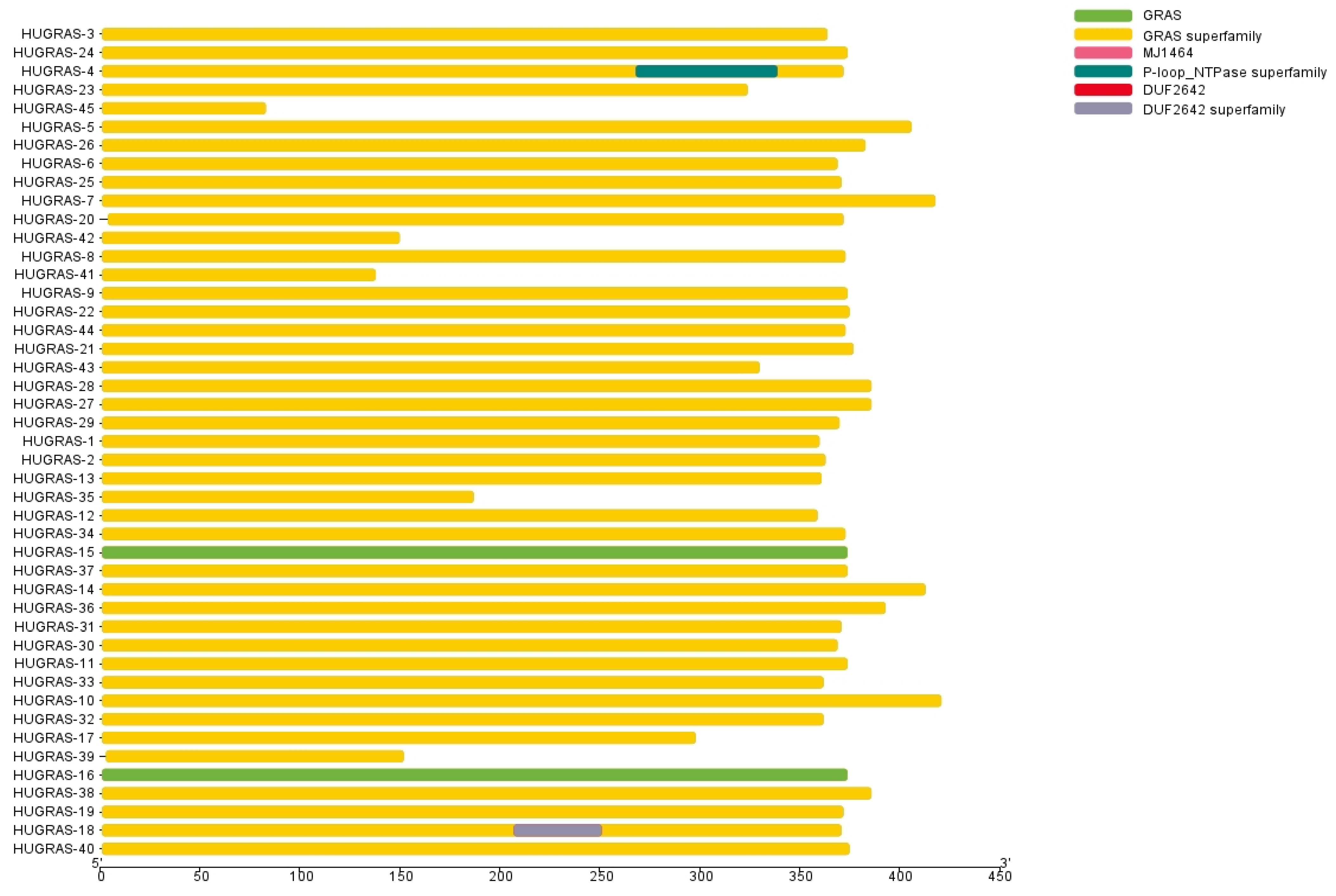
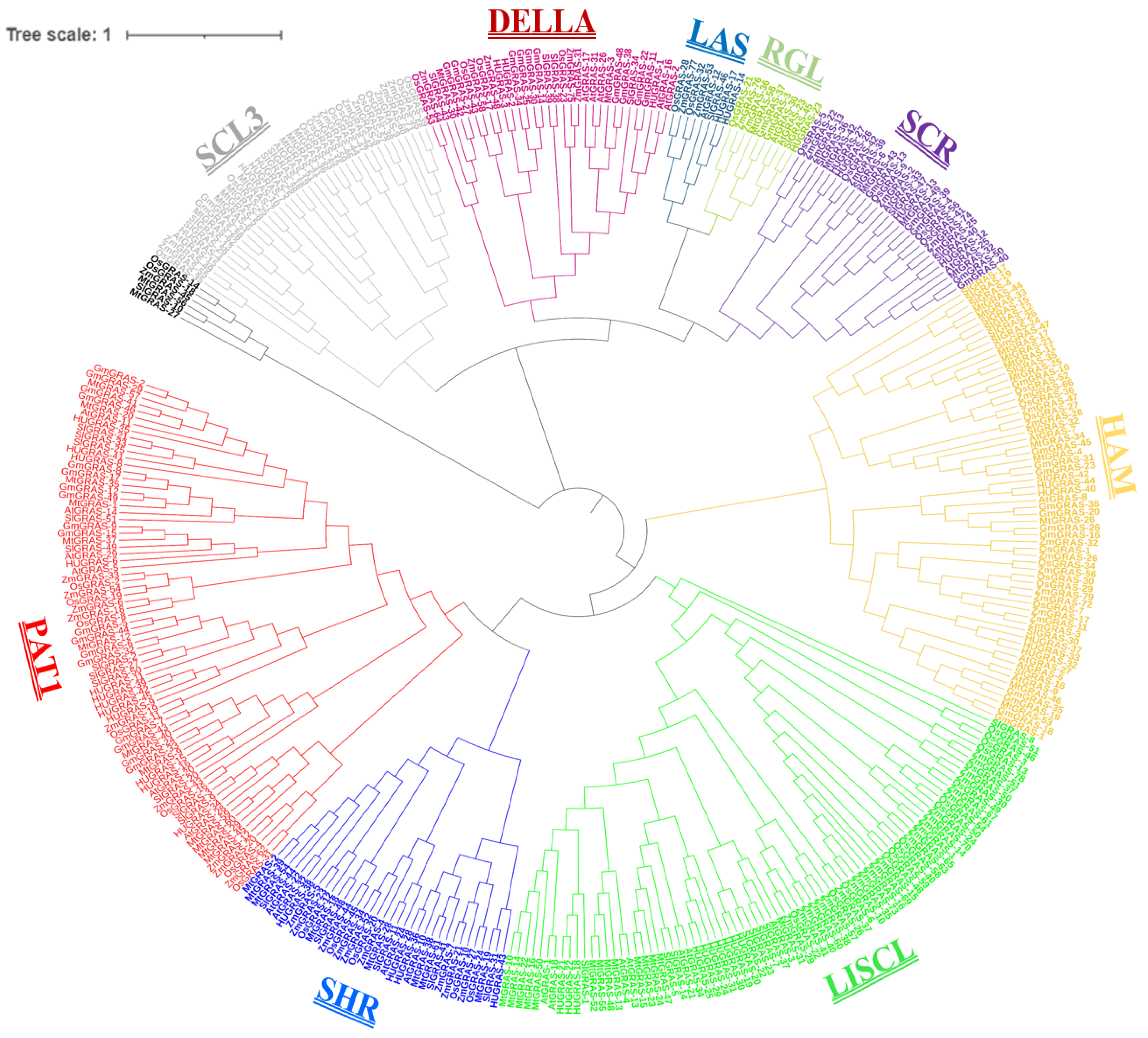
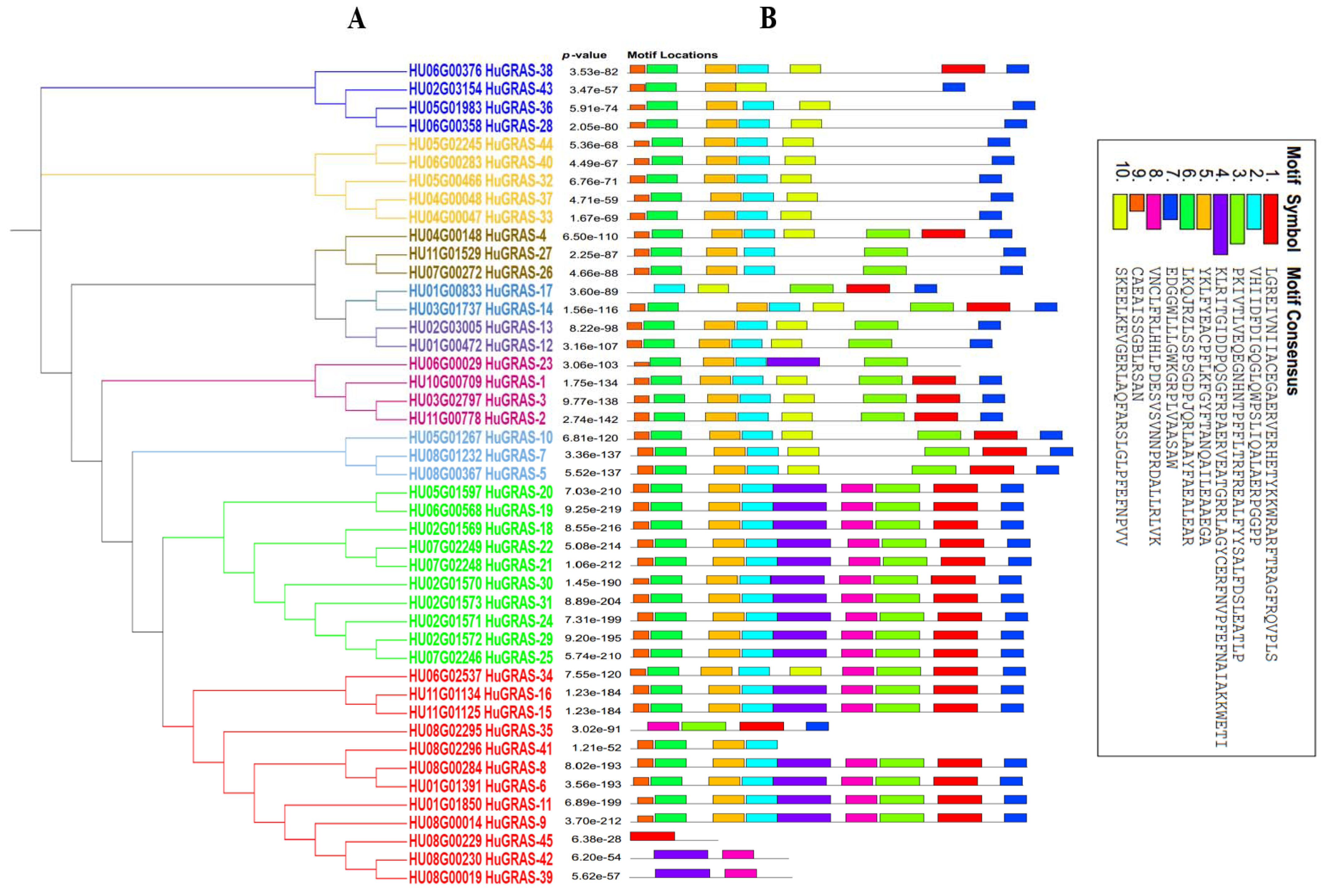
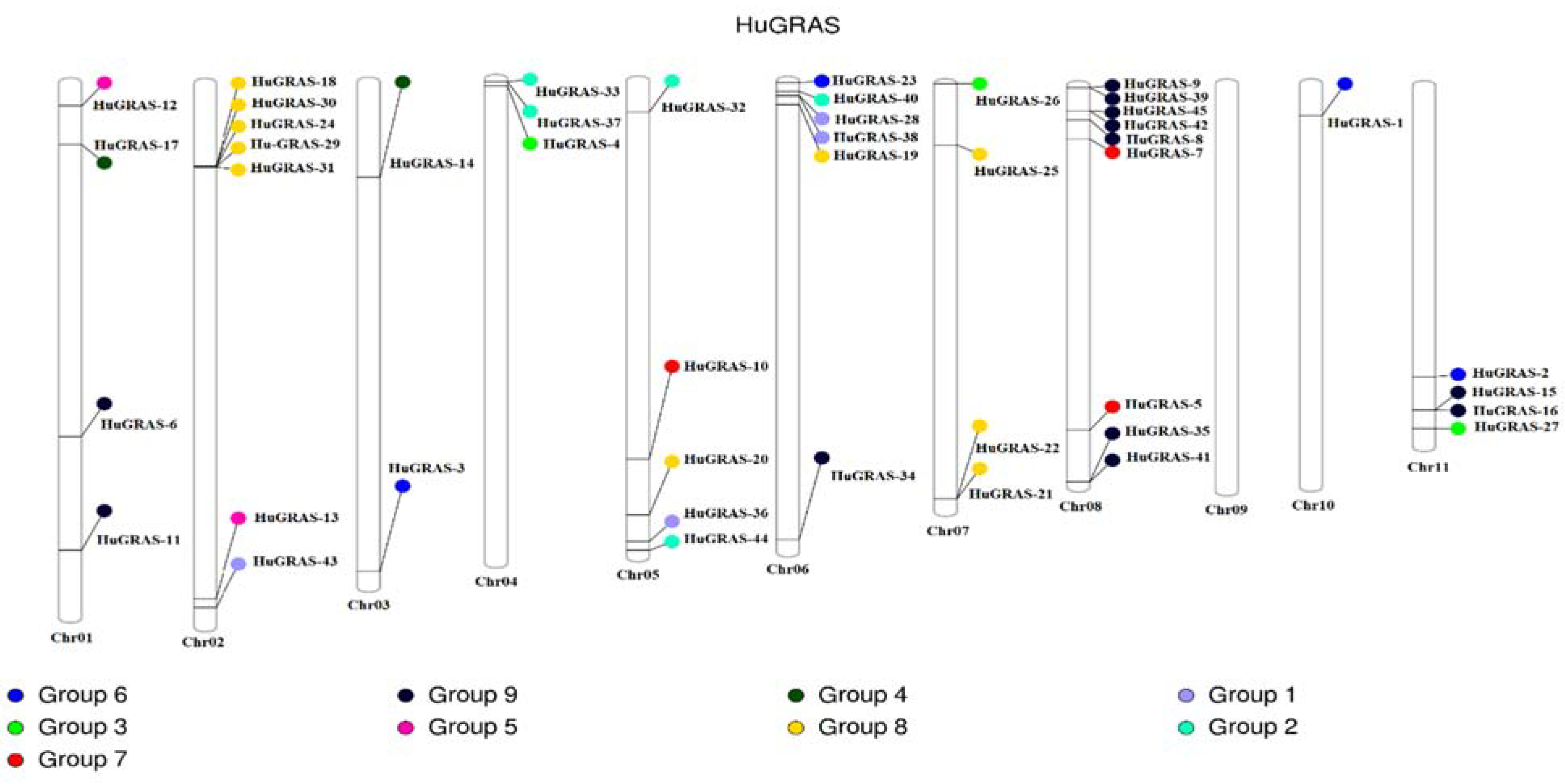
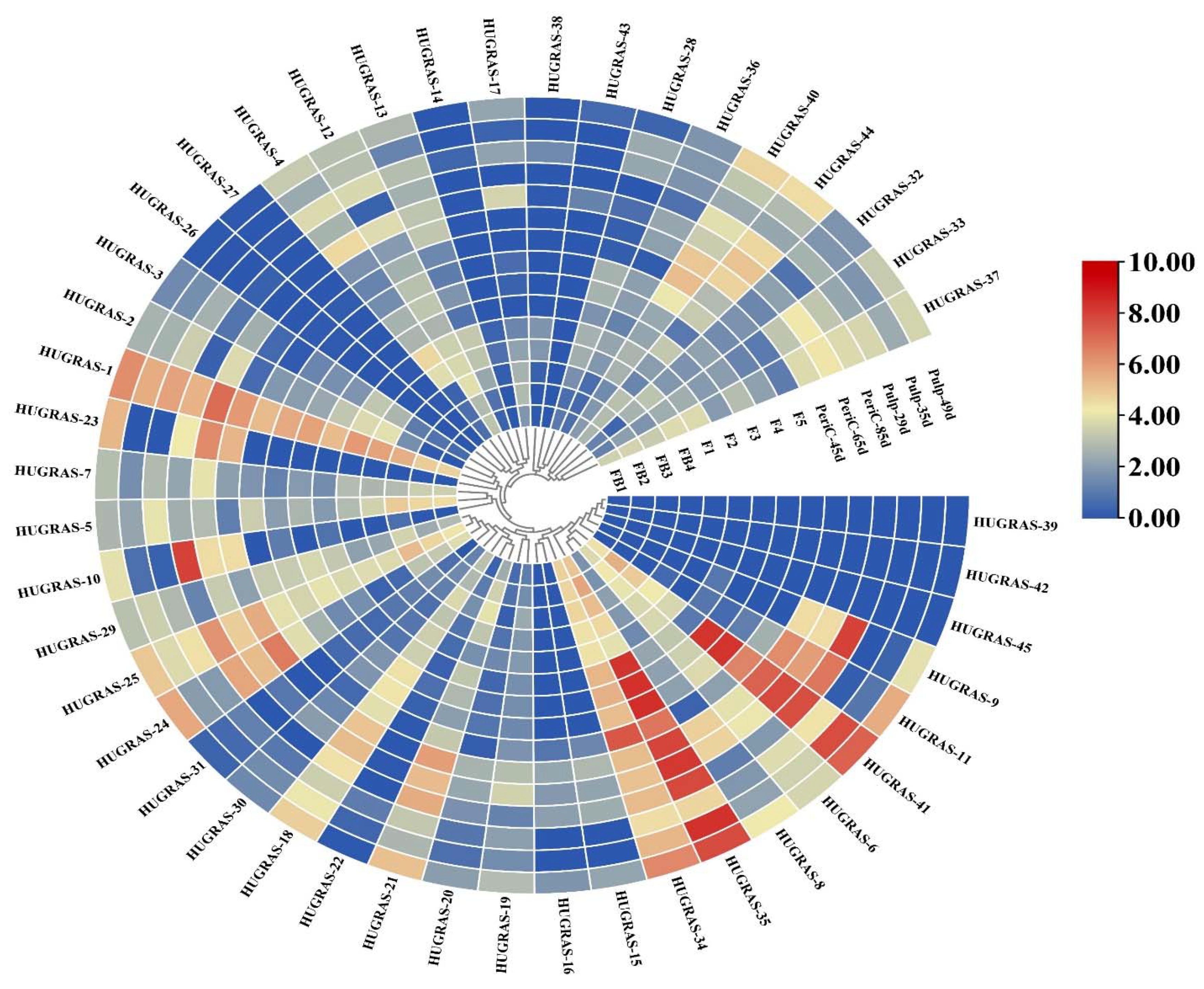
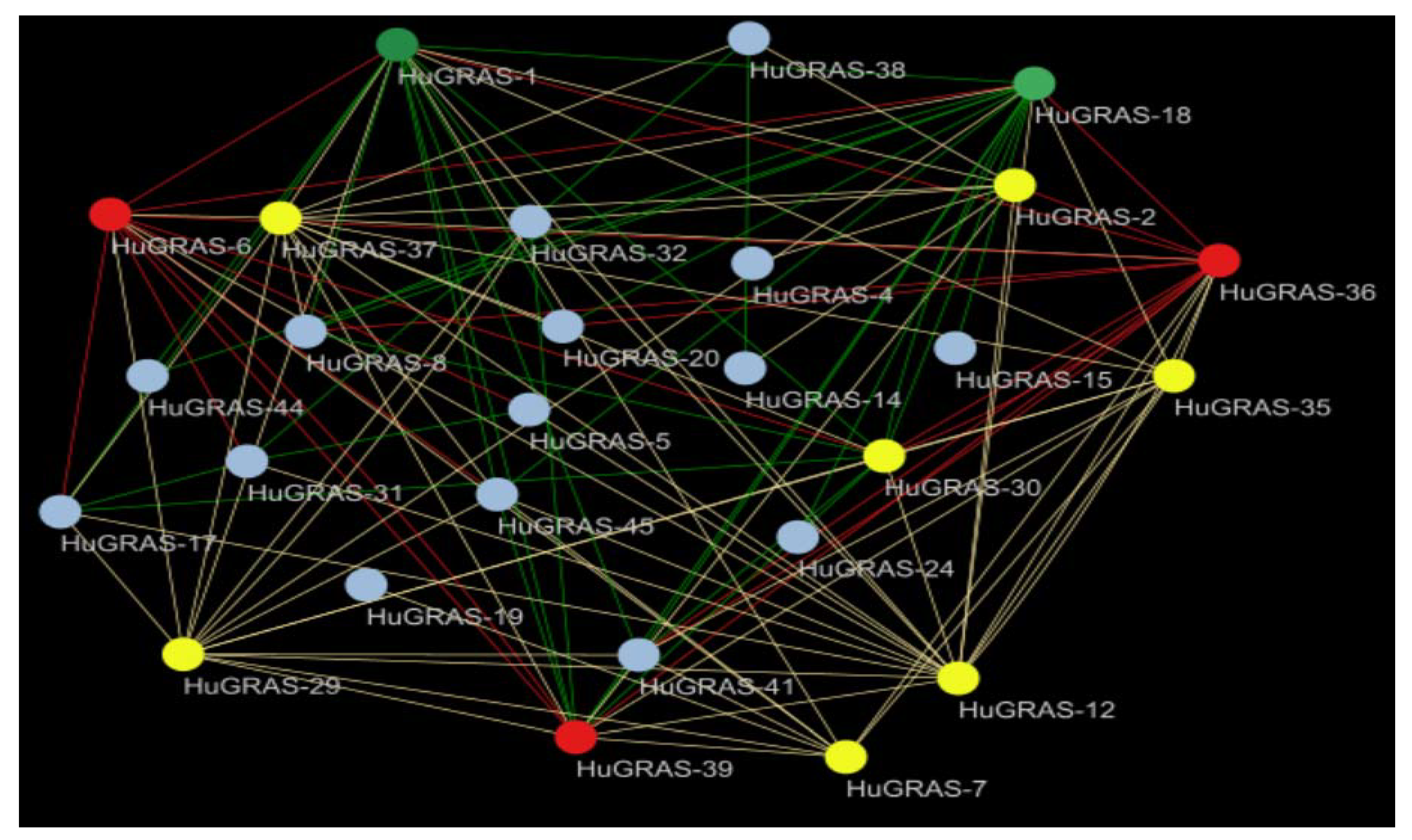
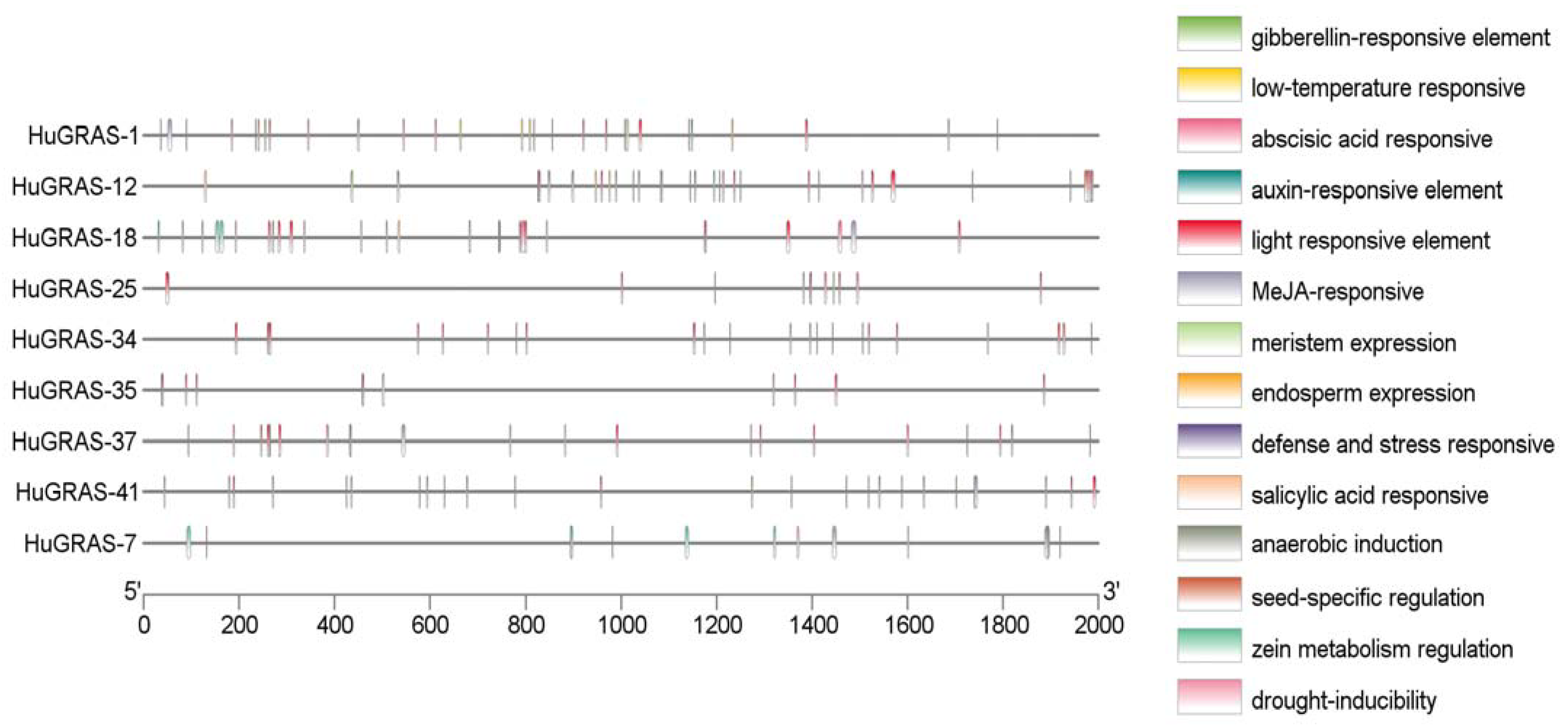
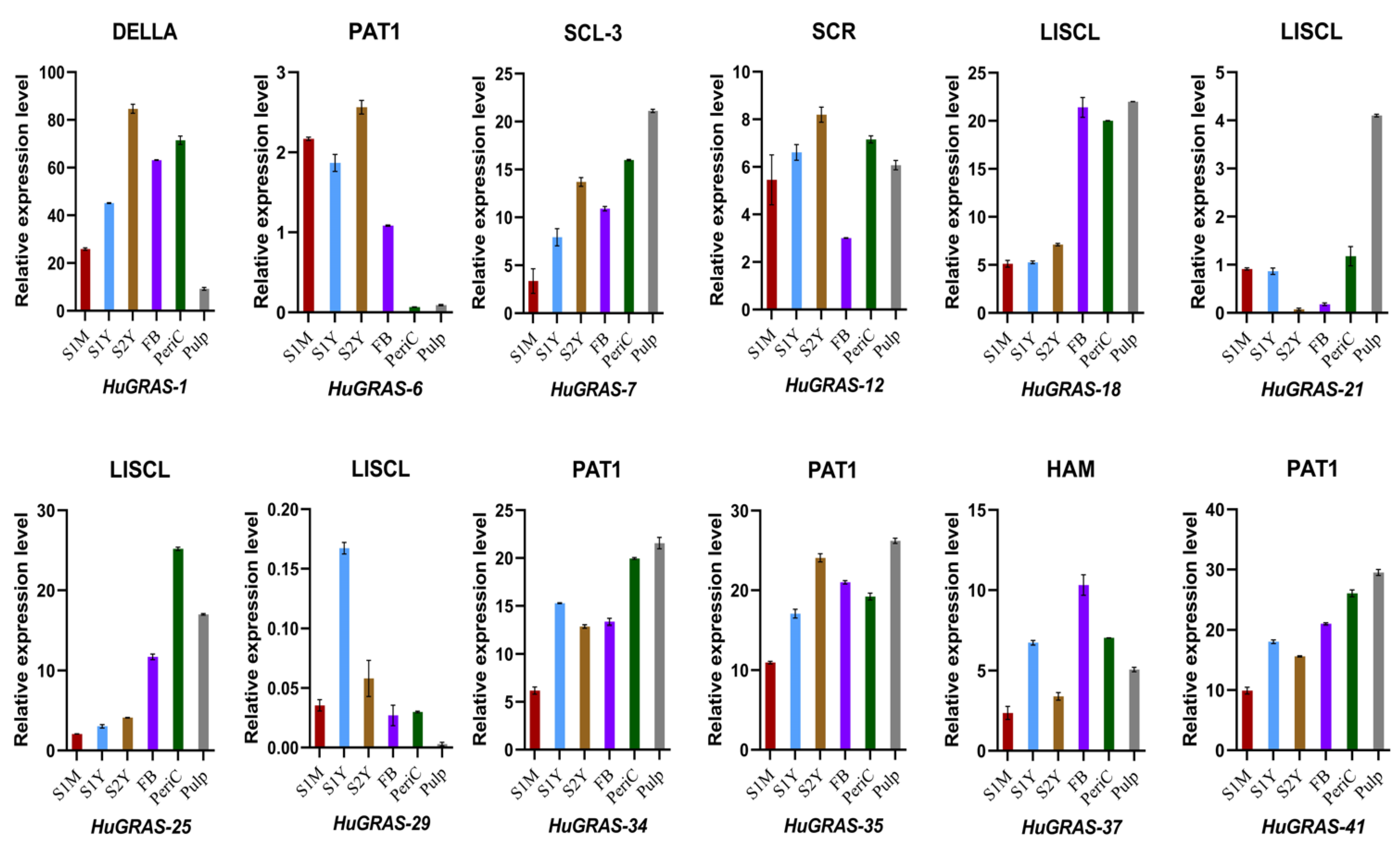
| Transcript ID | Renamed ID | Chr. No. | Start–End Position | CDS (bp) | Protein Length (AA) | Protein Mol. Weight (kDa) | pI | GRAVY |
|---|---|---|---|---|---|---|---|---|
| HU10G00709.1 | HuGRAS-1 | 10 | 8,621,296-8,623,893 | 1755 | 584 | 40.14 | 5.44 | −0.055 |
| HU11G00778.1 | HuGRAS-2 | 11 | 78,577,603-78,578,866 | 1176 | 391 | 39.90 | 6.63 | 0.105 |
| HU03G02797.1 | HuGRAS-3 | 3 | 132,126,059-132,127,531 | 1473 | 490 | 40.39 | 6.23 | −0.027 |
| HU04G00148.1 | HuGRAS-4 | 4 | 1,819,377-1,821,914 | 2055 | 684 | 42.26 | 5.89 | −0.221 |
| HU08G00367.1 | HuGRAS-5 | 8 | 14,545,649-14,547,799 | 1350 | 449 | 44.77 | 6.09 | −0.13 |
| HU01G01391.1 | HuGRAS-6 | 1 | 95,463,256-95,466,959 | 1623 | 540 | 41.20 | 6.9 | −0.101 |
| HU08G01232.1 | HuGRAS-7 | 8 | 93,024,447-93,026,894 | 1392 | 463 | 46.25 | 6.31 | −0.086 |
| HU08G00284.1 | HuGRAS-8 | 8 | 9,185,291-9,193,945 | 1533 | 510 | 41.50 | 5.91 | −0.067 |
| HU08G00014.1 | HuGRAS-9 | 8 | 524,930-530,436 | 1779 | 592 | 41.79 | 8.7 | −0.234 |
| HU05G01267.1 | HuGRAS-10 | 5 | 102,083,025-102,085,852 | 1332 | 443 | 46.94 | 5.99 | −0.12 |
| HU01G01850.1 | HuGRAS-11 | 1 | 126,187,756-126,191,336 | 1743 | 580 | 41.77 | 6.3 | −0.167 |
| HU01G00472.1 | HuGRAS-12 | 1 | 6,212,129-6,216,403 | 2430 | 809 | 38.49 | 5.76 | −0.016 |
| HU02G03005.1 | HuGRAS-13 | 2 | 138,909,434-138,911,167 | 1227 | 408 | 39.46 | 6.44 | −0.017 |
| HU03G01737.1 | HuGRAS-14 | 3 | 25,880,385-25,881,812 | 1428 | 475 | 46.22 | 6.57 | −0.19 |
| HU11G01125.1 | HuGRAS-15 | 11 | 87,396,169-87,400,880 | 1704 | 567 | 41.58 | 7.1 | −0.142 |
| HU11G01134.1 | HuGRAS-16 | 11 | 87,665,022-87,669,731 | 1704 | 567 | 41.58 | 7.1 | −0.142 |
| HU01G00833.1 | HuGRAS-17 | 1 | 16,765,953-16,767,335 | 1383 | 460 | 34.07 | 6.36 | −0.213 |
| HU02G01569.1 | HuGRAS-18 | 2 | 22,485,375-22,488,601 | 2283 | 760 | 42.05 | 8.6 | −0.24 |
| HU06G00568.1 | HuGRAS-19 | 6 | 6,285,841-6,289,986 | 2313 | 770 | 42.09 | 9.09 | −0.239 |
| HU05G01597.1 | HuGRAS-20 | 5 | 117,157,311-117,159,569 | 2259 | 752 | 42.17 | 9.46 | −0.236 |
| HU07G02248.1 | HuGRAS-21 | 7 | 112,127,788-112,125,521 | 2268 | 755 | 42.85 | 9.24 | −0.295 |
| HU07G02249.1 | HuGRAS-22 | 7 | 112,130,817-112,133,676 | 2265 | 754 | 42.53 | 8.96 | −0.298 |
| HU06G00029.1 | HuGRAS-23 | 6 | 372,597-376,546 | 1698 | 565 | 35.31 | 6.3 | −0.092 |
| HU02G01571.1 | HuGRAS-24 | 2 | 22,556,900-22,559,249 | 2001 | 666 | 42.22 | 8.95 | −0.18 |
| HU07G02246.1 | HuGRAS-25 | 7 | 112,113,563-112,116,265 | 1404 | 467 | 42.53 | 9.15 | −0.333 |
| HU07G00272.1 | HuGRAS-26 | 7 | 2,834,842-2,836,221 | 1380 | 459 | 42.87 | 5.5 | −0.18 |
| HU11G01529.1 | HuGRAS-27 | 11 | 92,622,998-92,624,392 | 1395 | 464 | 43.24 | 5.73 | −0.171 |
| HU06G00358.1 | HuGRAS-28 | 6 | 3,831,873-3,833,640 | 1458 | 485 | 42.91 | 5.98 | −0.24 |
| HU02G01572.1 | HuGRAS-29 | 2 | 22,590,054-22,592,716 | 2061 | 686 | 42.18 | 9.43 | −0.274 |
| HU02G01570.1 | HuGRAS-30 | 2 | 22,492,850-22,495,255 | 2406 | 801 | 42.68 | 8.1 | −0.436 |
| HU02G01573.1 | HuGRAS-31 | 2 | 22,646,432-22,648,477 | 2046 | 681 | 42.35 | 9.17 | −0.367 |
| HU05G00466.1 | HuGRAS-32 | 5 | 8,309,337-8,311,578 | 1770 | 589 | 39.79 | 6.86 | 0.143 |
| HU04G00047.1 | HuGRAS-33 | 4 | 727,912-731,196 | 2310 | 769 | 39.78 | 6.33 | 0.157 |
| HU06G02537.1 | HuGRAS-34 | 6 | 123,795,575-123,798,959 | 2289 | 762 | 40.48 | 7.86 | −0.138 |
| HU08G02295.1 | HuGRAS-35 | 8 | 106,955,054-106,955,638 | 585 | 194 | 21.76 | 8.89 | −0.617 |
| HU05G01983.1 | HuGRAS-36 | 5 | 124,288,256-124,289,817 | 1455 | 484 | 44.22 | 5.84 | −0.235 |
| HU04G00048.1 | HuGRAS-37 | 4 | 739,383-742,094 | 2016 | 671 | 41.56 | 6.59 | 0.059 |
| HU06G00376.1 | HuGRAS-38 | 6 | 4,097,194-4,098,474 | 1281 | 426 | 43.01 | 5.1 | 0.006 |
| HU08G00019.1 | HuGRAS-39 | 8 | 594,594-594,875 | 726 | 241 | 16.98 | 6.93 | −0.151 |
| HU06G00283.1 | HuGRAS-40 | 6 | 594,594-602,896 | 1371 | 456 | 40.78 | 8.54 | 0.127 |
| HU08G02296.1 | HuGRAS-41 | 8 | 106,955,745-106,956,677 | 933 | 310 | 15.39 | 7.01 | 0.115 |
| HU08G00230.1 | HuGRAS-42 | 8 | 6,804,389-6,812,672 | 723 | 240 | 16.67 | 7.95 | −0.181 |
| HU02G03154.1 | HuGRAS-43 | 2 | 141,447,089-141,448,403 | 1185 | 394 | 37.68 | 5.87 | 0.42 |
| HU05G02245.1 | HuGRAS-44 | 5 | 126,702,616-126,704,494 | 1617 | 538 | 40.33 | 8.52 | 0.201 |
| HU08G00229.1 | HuGRAS-45 | 8 | 6,804,079-6,804,372 | 294 | 97 | 95.15 | 9.56 | −0.032 |
Disclaimer/Publisher’s Note: The statements, opinions and data contained in all publications are solely those of the individual author(s) and contributor(s) and not of MDPI and/or the editor(s). MDPI and/or the editor(s) disclaim responsibility for any injury to people or property resulting from any ideas, methods, instructions or products referred to in the content. |
© 2022 by the authors. Licensee MDPI, Basel, Switzerland. This article is an open access article distributed under the terms and conditions of the Creative Commons Attribution (CC BY) license (https://creativecommons.org/licenses/by/4.0/).
Share and Cite
Zaman, Q.U.; Hussain, M.A.; Khan, L.U.; Cui, J.-P.; Hui, L.; Khan, D.; Lv, W.; Wang, H.-F. Genome-Wide Identification and Expression Pattern of the GRAS Gene Family in Pitaya (Selenicereus undatus L.). Biology 2023, 12, 11. https://doi.org/10.3390/biology12010011
Zaman QU, Hussain MA, Khan LU, Cui J-P, Hui L, Khan D, Lv W, Wang H-F. Genome-Wide Identification and Expression Pattern of the GRAS Gene Family in Pitaya (Selenicereus undatus L.). Biology. 2023; 12(1):11. https://doi.org/10.3390/biology12010011
Chicago/Turabian StyleZaman, Qamar U, Muhammad Azhar Hussain, Latif Ullah Khan, Jian-Peng Cui, Liu Hui, Darya Khan, Wei Lv, and Hua-Feng Wang. 2023. "Genome-Wide Identification and Expression Pattern of the GRAS Gene Family in Pitaya (Selenicereus undatus L.)" Biology 12, no. 1: 11. https://doi.org/10.3390/biology12010011





